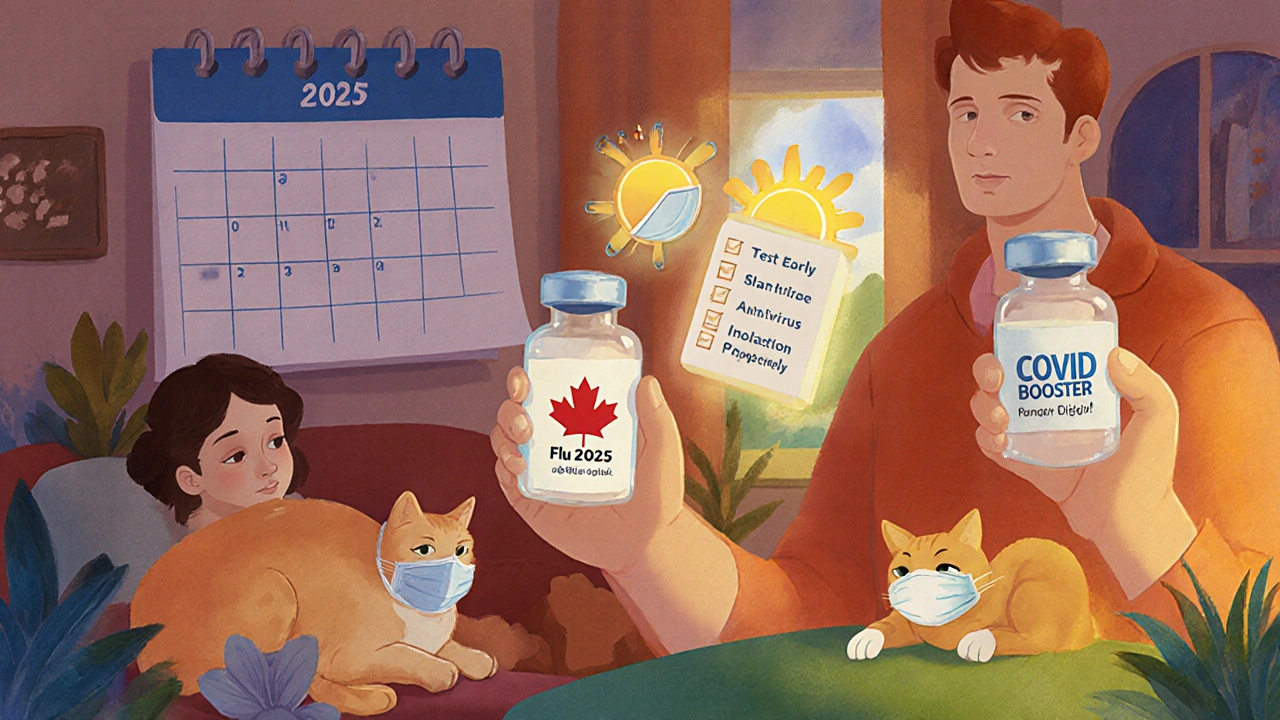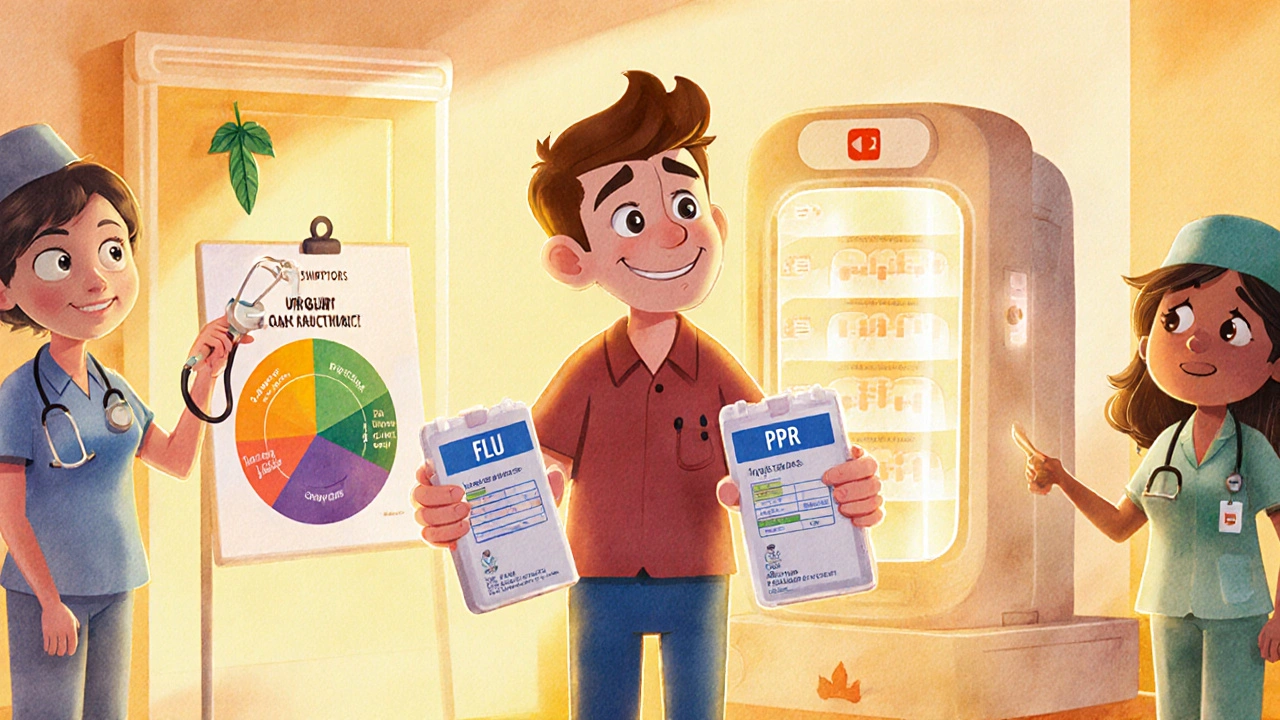How to Tell Influenza and COVID-19 Apart in 2025
You wake up with a fever, sore throat, and body aches. Is it the flu? Or is it COVID-19? In 2025, the answer isn’t as simple as it used to be. For the first time since the pandemic began, influenza caused more hospitalizations and deaths than COVID-19 during the peak of the 2024-2025 season. That shift changed everything-how doctors test, how hospitals treat, and how long you need to stay home.
Both illnesses hit hard with similar symptoms: cough, fatigue, fever, chills. But the differences matter. Loss of taste or smell? That’s far more likely with COVID-19-happening in 40-80% of cases versus just 5-10% with flu. Bacterial pneumonia? More common with flu. Pure viral pneumonia? More common with COVID-19. These aren’t just academic details. They guide what tests you get, what drugs you take, and how long you stay isolated.
Testing: What Works Now and What Doesn’t
Back in 2020, you might’ve waited days for a PCR result. Today, most urgent care centers and hospitals use multiplex PCR panels that test for flu A/B, COVID-19, and RSV all at once. By early 2025, 87% of U.S. hospitals had switched to this method. Why? Because symptoms overlap too much. A negative rapid flu test doesn’t rule out flu. A negative rapid COVID test doesn’t mean you’re clear either.
Here’s what the numbers show:
- Flu antigen tests: 75-85% sensitive
- COVID-19 antigen tests: 80-90% sensitive
- Multiplex PCR: over 95% accurate for both
That’s why if you’re high-risk-over 65, pregnant, diabetic, or on immunosuppressants-don’t rely on a quick at-home test. Go to a clinic for a PCR. A false negative could cost you your health. And if you’re in a hospital or nursing home, they’re testing everyone with respiratory symptoms, no matter how mild. The CDC says 92% of healthcare facilities now require testing for both viruses before discharge.
Treatment: Which Antivirals Work and When
Time is everything. For flu, antivirals like oseltamivir (Tamiflu) work best if taken within 48 hours of symptoms. In the 2024-2025 season, they cut hospitalization risk by 70% when used early. But here’s the catch: only 63% of hospitalized flu patients got them on time. Many waited too long.
For COVID-19, Paxlovid (nirmatrelvir/ritonavir) is the go-to. It’s 89% effective at preventing hospitalization if taken within five days. But in 2025, only 41% of hospitalized COVID patients got it within that window. Why? Some didn’t know they had it. Others couldn’t afford it-insurance covered flu antivirals for 87% of patients, but only 63% for Paxlovid.
And now, there’s a new option. In January 2025, the FDA approved a new flu antiviral-a prodrug of zanamivir-with 92% effectiveness against the H1N1 pdm09 strain dominating this season. It’s not widely available yet, but it’s coming. Meanwhile, Paxlovid’s eligibility expanded in February 2025 to include mild cases with risk factors like obesity or asthma. If you’re in that group, don’t wait. Call your doctor the moment symptoms hit.
Isolation: How Long to Stay Home
The CDC says five days for both. But that’s where the similarity ends.
For flu: You can end isolation after 24 hours without fever (no fever-reducing meds) and improving symptoms. You might still be shedding virus, but you’re no longer contagious enough to spread it widely. Most adults shed flu virus for 5-7 days. Kids? Up to 14 days.
For COVID-19: Five days isn’t enough. You need a negative rapid antigen test on day five. If it’s still positive, keep isolating until day seven. Why? The Omicron XEC subvariant lingers longer. Viral load stays high, especially in the upper airways. A 2025 study from the University of Nebraska found that 35% of COVID patients were still shedding infectious virus on day seven, compared to just 8% of flu patients.
Healthcare workers have it tougher. In hospitals, 92% require N95 masks for staff caring for COVID patients. For flu? Only 68%. That’s because COVID spreads more easily in closed spaces. If you’re immunocompromised or live with someone who is, don’t take chances. Test before you return to work or visit family.
Who’s at Higher Risk?
It’s not just age. The 2024-2025 data showed clear patterns:
- COVID-19 patients were more likely to have chronic kidney disease, cancer, or be on immune-suppressing drugs.
- Flu patients were more likely to have no underlying conditions-42% had none, compared to 28% of COVID patients.
- Flu patients were more likely to have been vaccinated in the past year-67% vs. 49% for COVID.
That’s why getting both vaccines matters. In 2025, 52.6% of Americans got the flu shot. Only 48.3% got the updated COVID booster. The gap is closing, but it’s still there. And it’s costing lives.
If you’re over 50, pregnant, or have asthma, COPD, or heart disease-you’re in the high-risk group for both. Don’t assume one vaccine protects you from the other. They’re different viruses. You need both shots.

What to Do When You’re Sick
Here’s a simple action plan for 2025:
- Stay home the moment you feel unwell. Don’t wait for a test.
- Call your doctor or visit an urgent care center within 24 hours. Ask for a multiplex PCR test.
- If you’re high-risk, ask about antivirals immediately. Don’t wait for the test results if symptoms are worsening.
- Isolate for five days. For flu, end isolation after 24 hours fever-free. For COVID, test on day five. If positive, keep going.
- Wear a mask around others for five more days after ending isolation, especially indoors.
- Get both vaccines next fall. Don’t wait until you’re sick.
One nurse in Massachusetts told Reddit users in February 2025: “We had 30% of patients come in thinking it’s the flu, but their test says COVID. They didn’t realize how different the rules are.” Don’t be one of them.
What’s Changing in 2025-2026
The CDC’s 2025-2026 outlook warns: don’t get comfortable. If a new immune-escape variant of SARS-CoV-2 emerges, hospitalizations could spike again. The same modeling shows flu could surge again too. That’s why hospitals are rolling out “respiratory pathogen stewardship programs”-algorithms that tell doctors exactly when to test, when to treat, and when to isolate.
At-home combined tests are getting better. BinaxNOW’s new flu/COVID test is 89% accurate for both. But it’s not perfect. If you’re still symptomatic after a negative result, test again. Or get a PCR.
And the big picture? Doctors are moving away from treating flu and COVID as separate problems. They’re learning to manage them together. As Dr. Ashish Jha wrote in NEJM: “The era of treating respiratory pathogens in isolation has ended.”
That means you need to know the differences. Because when it comes to your health, the right answer isn’t guesswork. It’s data. It’s timing. It’s action.
Can I have both flu and COVID-19 at the same time?
Yes. Co-infections happen. During the 2024-2025 season, about 5-8% of patients tested positive for both viruses. Symptoms can be worse, and hospital stays tend to be longer. That’s why multiplex testing is now standard-it catches both at once.
Do I need to get tested if I’m vaccinated?
Yes. Vaccines reduce severity, but they don’t prevent infection completely. You can still catch either virus, especially with new variants. Testing helps you get the right treatment and stop spreading it to others.
Why is Paxlovid harder to get than Tamiflu?
Paxlovid has more complex drug interactions-it can’t be taken with many common medications like statins or blood thinners. Insurance companies also have stricter rules for coverage. Tamiflu has been around longer, is cheaper, and has fewer restrictions. But if you’re eligible, ask for it. It works.
Can I go to work after five days if I feel better?
For flu: Yes, if you’ve been fever-free for 24 hours and symptoms are improving. For COVID: Only if your rapid test is negative on day five. If it’s still positive, wait until day seven. Even if you feel fine, you might still be contagious.
Is it safe to be around babies or elderly people after I recover?
Wait at least five more days after ending isolation, and wear a mask around them. Viral shedding can continue even after symptoms fade. Babies and older adults are especially vulnerable to complications from both viruses. Better safe than sorry.


vinod mali
November 17, 2025 AT 13:07Jennie Zhu
November 18, 2025 AT 17:07Kathy Grant
November 19, 2025 AT 15:57Robert Merril
November 20, 2025 AT 08:03Noel Molina Mattinez
November 21, 2025 AT 12:35Roberta Colombin
November 21, 2025 AT 17:46Dave Feland
November 22, 2025 AT 20:59Ashley Unknown
November 23, 2025 AT 07:19Georgia Green
November 24, 2025 AT 10:54Christina Abellar
November 25, 2025 AT 05:00Eva Vega
November 25, 2025 AT 11:15Matt Wells
November 25, 2025 AT 20:40